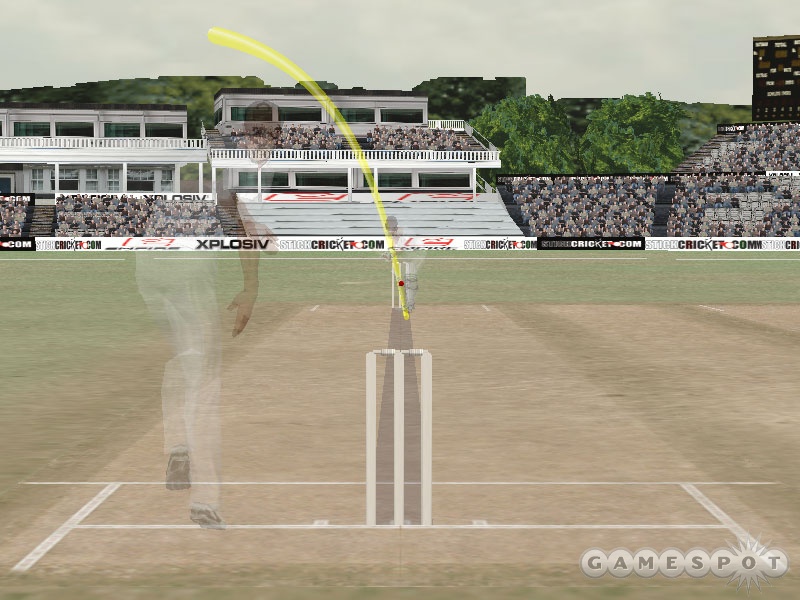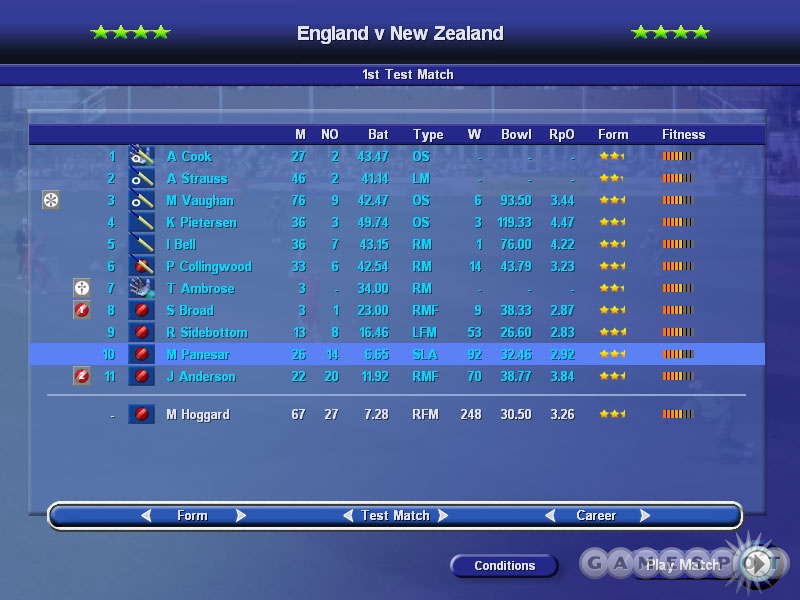International Cricket Captain 2008 for the PC builds on the changes introduced in last year's version of the game, including the new 3D engine, but ultimately this year's edition is little more than an incremental statistical update. Although these revisions will represent a lot of value to the hardcore statistic fans, the overall experience is still hampered by a slight identity crisis and serves only to cheapen a sport loved by so many.

As a brief recap for those unfamiliar with the series, International Cricket Captain is a sporting-team supervision sim that puts you in the role of coach to both English domestic-county cricket and international side management. In it, you'll manage all aspects of the team, including their fitness, physio, and training on and off the field. The full game mode lets you take control of a county team with the ultimate goal of producing a side worthy of a national captain nomination. County and international mode makes a return this year, and sees you picking both a domestic and international team to manage with the goal of finishing at the top of the boards. Managing two teams presents its own challenges, and in addition to the matches themselves, you'll need to cope with player shuffling within your ranks as your players are called up to fulfill obligations to national teams. Not surprisingly, the players with the best stats and form are called up, which puts performance dents in your team that you'll need to work around by keeping a working substitution bench. Given that you're dealing with county players, this gameplay mode also gives you the chance to use your talent-scouting eye to pick out and mould in your image the up-and-coming players before they get big. With a little careful management and training, you may have the next Shane Warne or Ricky Ponting on your hands. If managing household-name talent is more your thing, then the International Career mode will let you get straight into the big leagues to take your choice of team to glory.
One fundamental issue raises its head again in the 2008 edition of ICC. The game straddles the line between giving players the chance to play as cricket captain and as a team manager, and the two don't always overlap. The on-field direction of who will bowl and bat, when they'll do it, and how the fieldsmen will be placed is all captain territory. On the other hand, between matches you'll need to manage player training and fitness by spending your allocated number of skill points. ICC '08 has added new coaching options, and whereas previously all you could do was assign generic bowling or batting training to players, you're now able to designate work in specific areas such as improving aggressive or defensive skills. Each player profile includes information on his preferred play style, so over time and with a guiding hand you can help correct players' shortcomings. Like ICC III last year, though you can play it as a pure management game, you'll still be penalised for skipping playing matches; you won't be able to set advanced tactics such as aggression, player rotations, or night watchmen if you lose several wickets cheaply. Thankfully, you can choose the highlight coverage and limit it accordingly to every ball, runs and wickets, fours and wickets, chances, and wickets only to speed things up.
Considering that this is a management rather than an action game, you'll spend most of your time navigating menus and pages of numbers to select players and manage what they're doing. Unfortunately, when you do venture into the 3D engine for matches, it's a rather lacklustre experience. Two video options are offered: windowed and full-screen mode. The smaller of the two is easier on the eyes simply because the models are scaled down, but full-screen mode is embarrassing. Granted, this is not a game that prides itself on its graphical prowess, but the abundance of low-resolution textures repeated ad nauseam is enough to make you wince. There appears to have been no visual upgrade since last year, and like ICC III, the game has what appears to be a single character model that is shared across both teams as well as the umpires. The model varies only by hair colour, outfit, and occasionally facial hair. House ads for ICC's developer Xplosiv and distributor Empire Interactive pepper the boundary. Character animations are uneven, with shots such as on-drives appearing fluid and natural, whereas running between wickets and diving in the outfield appear jerky and inconsistent. Players often dive and appear to stop the ball, but then the camera continues to pan around the ground while the commentary and umpire signal four runs. Clipping errors are still par for the course here, and it's not uncommon to see bats pass through the legs of players. Interestingly, though umpires can now signal sixes using clearly articulated single fingers, LBW dismissals are still indicated using a whole hand and come off somewhere between a friendly wave and a salute to the Fuhrer.
Given that this is a mostly hands-off cricket experience and that you'll never actually control the swing of a bat or choose which delivery will be bowled, you'll need to rely on the in-game Hawk-Eye bowling graphs to gauge how you're doing. The bowling and batting systems have received a slight visual tweak from last year, with slider bars now reoriented from a vertical to a horizontal position, but functionally they work the same way. Sliding to the right boosts your aggression and makes you more likely to score runs and potentially lose your wicket depending on your comfort at the crease. Moving the bar left plays more defensive shots and is useful for fresh players after the fall of a wicket. Your ability to change the line and length of your bowling has been brought out of the respective minimenus and is now faster to adjust on the fly. One of the biggest changes here is that, when you're bowling and choosing an aggressive approach, your field will automatically reposition. You're still able to manually change where fielders stand from five presets or by creating a custom field, but it's a nice feature for anyone who rapidly changes between bowling styles.

Jonathan "Aggers" Agnew makes a return to the commentary seat in the 2008 version, but the small selection of audio samples--a large percentage of which appears to be recycled from last year's game--quickly grow stale and often simply don't fit the onscreen action. At one point, Aggers chimed in on an absolutely plum LBW dismissal with "Nine times out of 10 the batsmen would have survived, but you've got to go." Likewise, a ball that was clearly swinging down the offside of a right-handed batsman was met with the suggestion that he was lucky to survive the attempt. Ambient crowd audio consists of polite applause whenever anything happens.
Although it has received a slight interface overhaul and some minor gameplay tweaks, some of the inherent shortcomings of the International Cricket Captain series remain. Inconsistent character animations, lacklustre visuals, and the penalty for skipping matches hamper what is at its core a competent sports-management simulation.